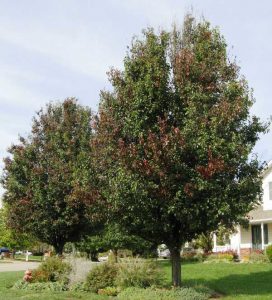Gardeners in Northwest Florida were blessed this spring with conditions conducive to great gardening, mild weather and plenty of rain. However, with those pleasant conditions has come an unusually high occurrence of Fireblight. Cases of Fireblight have been brought into our office almost daily this spring/early summer!

Fireblight is a difficult to control, rapidly-spreading disease caused by a bacterium (Erwinia amylovora) that affects many fruit trees, especially apple and pear but is also seen on quince, crabapple, hawthorn, loquat and photinia. Fireblight is generally noticed in late winter and early spring during periods of frequent rainfall as the plant begins to bloom and leaf out. The bacterium enters the plant through the opening flowers causing them to blacken and die. The disease then makes its way down the infected stem, destroying newly developing twigs along the way. Most homeowners notice the problem at this point in the progression; the new shoots have died, turned black and hold on the plant, giving it the tell-tale “burned” look. Homeowners also generally notice sunken lesions, or cankers, that form on the infected stems.
So, with a problem as unpredictable and destructive as Fireblight, what can one do to prevent it or combat its spread? There is no one method that can prevent or cure a Fireblight infection but there are several precautions homeowners can make to mitigate its effects.
- Plant resistant species and/or resistant cultivars of susceptible species, such as pear and apple. Under conditions like we’ve had this year, no pear or apple is immune but these cultivars have some proven resistance:
- Edible Pear: ‘Keiffer’, ‘Moonglow’, ‘Orient’
- Apple: ‘Anna’, ‘Dorsett Golden’
- Ornamental Pear: ‘Bradford’, ‘Cleveland Select’
- Remove infected and dead wood when the tree is dormant. Make a clean cut at least 12” below the last sign of infected wood and dispose of it. It is always a good practice to sanitize your pruners between cuts on a diseased tree. Also, there is little evidence to suggest that pruning out diseased wood on actively growing plants has much effect on further disease spread as long as conditions are still suitable for Fireblight formation.
- If you have noticed Fireblight on your trees in the previous year, it is good practice to make a preventative spray of a copper fungicide prior to the plant breaking dormancy.
- During bloom, streptomycin may be applied every three or four days for the duration of the bloom cycle to prevent infection. Consult the label for required days between spraying and consumption.
Fireblight is bad news in a fruit orchard but homeowners can take heart in the fact that the condition is not always fatal, especially if the preventative measures outlined above (proper cultural practices, proper pesticide use, and planting of resistant cultivars) are taken!
 0
0
